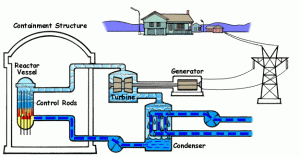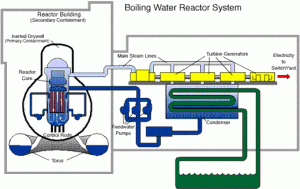The information on this page was prepared by:
| Jenny Chan | jenny.chan@usc.edu | Biomedical/Biochemical Engineering |
Boiling Water Reactor Background
Background
Boiling Water Reactor or BWR is a type of nuclear reactor in which the water, used both as coolant or moderator, is allowed to boil in the core. The steam that is produced has a pressure of about 1000lbs per square inch and can be used directly to drive a turbine and electrical generator – producing electricity. It has many similarities to the Pressurized Water Reactor (PWR), and the only difference is that there is only a single circuit in which the water is a lower pressure. This reactor operates at about 70 atmospheres in which the water boils in the core at about 285�C. The BWR design has a Carnot efficiency of only 42% and a practical operating efficiency of about 33%, which is slightly less than the PWR. Just like the PWR, the reactor core will continue to produce heat from radioactive decay after the fission reactions have stopped. Therefore, it is possible for a nuclear meltdown in the event that all safety systems fail and the core does not receive adequate cooling.
Process
How exactly does the BWR work? First, water is circulated through the reactor core, which absorbs heat from the fuel assemblies. Some of the water is converted to steam from the heat and pass through steam separators at the top of the reactor. This helps remove water from the steam, and then travels pass the main stream lines to the turbine generaters. The steam typically enters the smaller high pressure turbine, and then passes through moisture separators. Afterwards, it travels through 2 to 3 larger low pressure turbines, which are connected to the generator. About 20,000 volts AC of electricity are produced by the generator and then distributed to a generator transformer, which further increases the electricity produced to either 230,000 or 345,000 volts. The power is then distributed to a switchyard or substation where the power is then sent offsite. The steam that passed through the turbines continues to condense in the condenser, which is cooled by the ocean, sean, lake, or river water, and kept at a vacuum. The condensed steam is now pumped to the low pressure feedwater heaters and the water then passes to the feedwater pumps. The feedwater pumps pump the water to the reactor and the cycle starts all over again. The BWR has two unique features, one being that the control rods are inserted from the bottom by a high pressure hydraulically operated system. The other feature is that the BWR has a torus or suppression pool, which removes released heat if an event occurs in which large quantities of steam are released from the reactor or reactor re-circulation system. Sources:
Sources:
1. http://en.wikipedia.org/wiki/Boiling_water_reactor
2. http://www.nucleartourist.com/type/bwr.htm
3. http://www.eng-tips.com/gviewthread.cfm/lev2/19/lev3/64/pid/466/qid/16663
4. http://hyperphysics.phy-astr.gsu.edu/hbase/nucene/reactor.html#c2